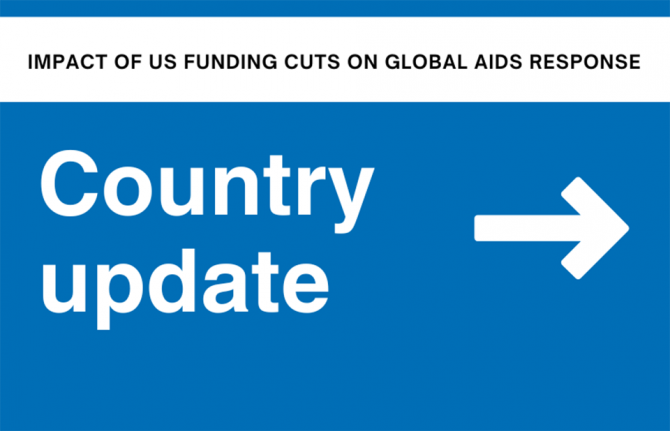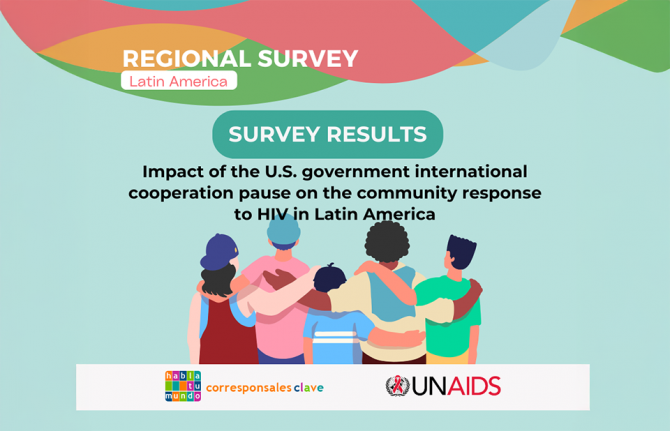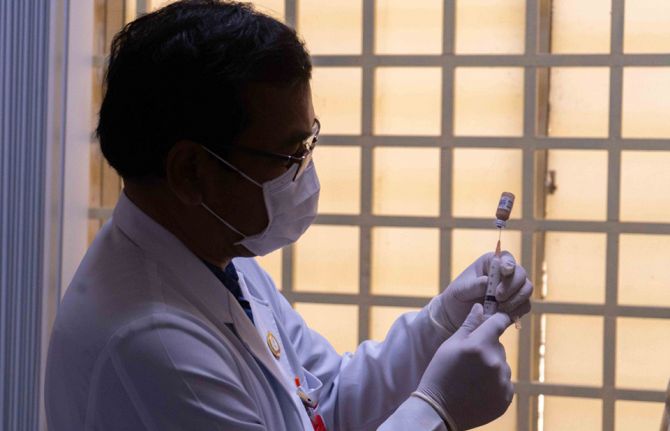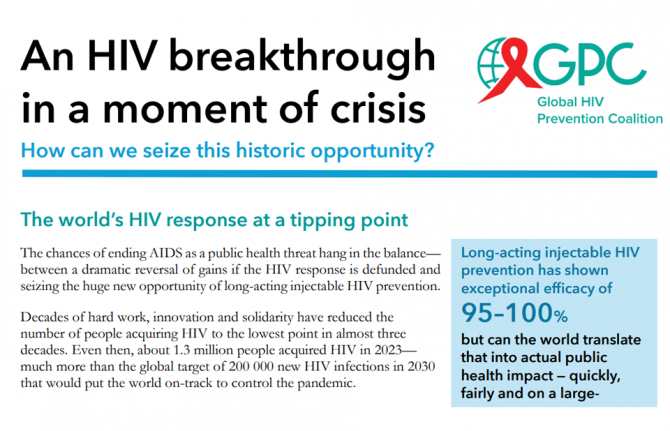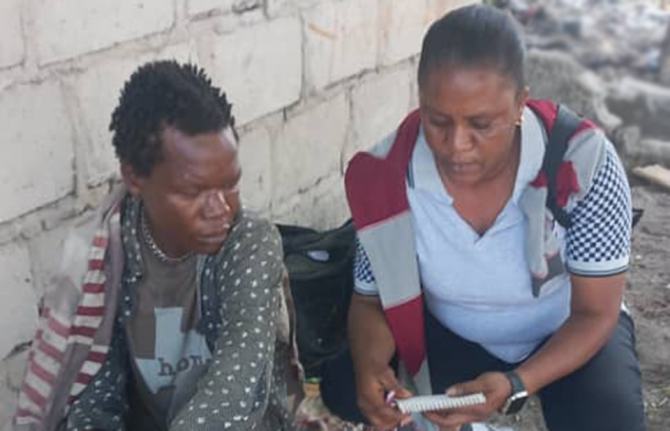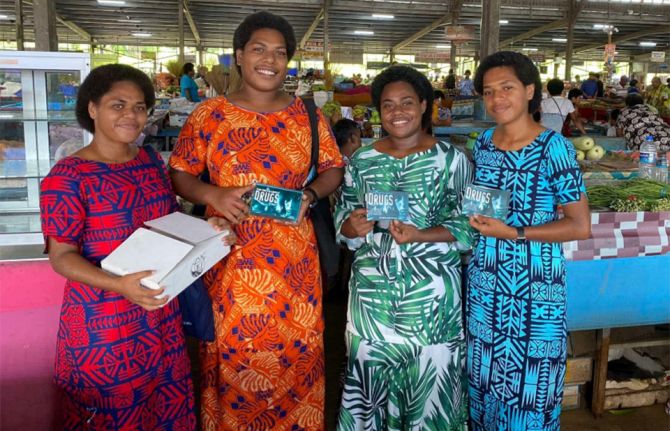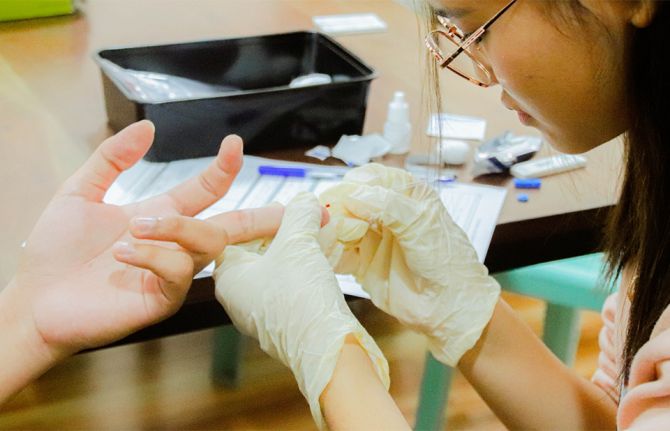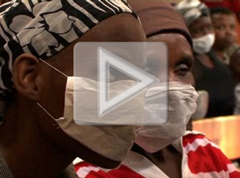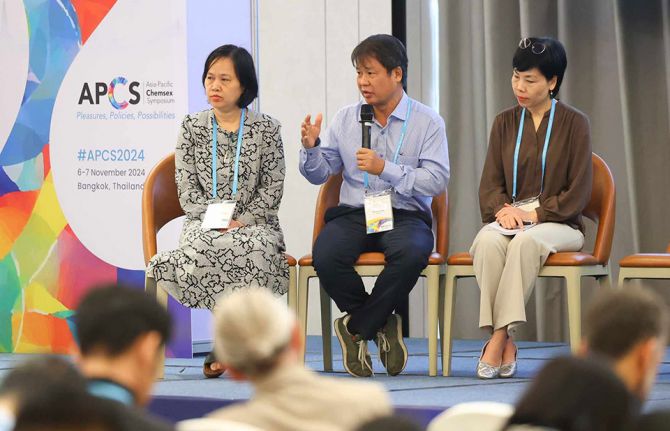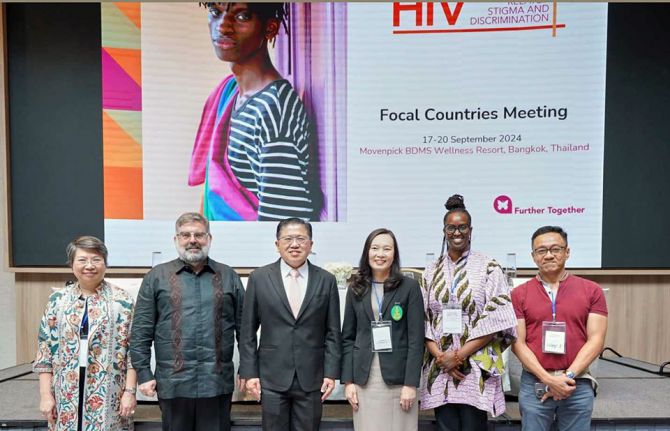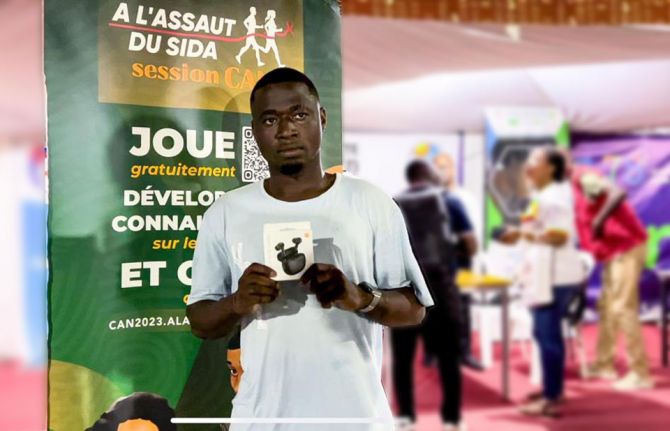
Feature Story
UNAIDS Executive Director meets with TB Programme Managers, TB civil society
26 March 2009
26 March 2009 26 March 2009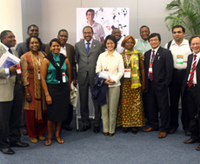
Michel Sidibé, UNAIDS Executive Director met with National Tuberculosis Programme Managers and Civil Society representatives at the 3rd Stop TB Partners Forum in Rio de Janeiro, Brazil, on 24 March 2009. Credit:UNAIDS/D. Ramalho
Mr Michel Sidibé, the Executive Director of UNAIDS, met with managers of national TB programmes and civil society representatives at the 3rd Stop TB Partners Forum to hear their views on ways to improve the joint response to TB and HIV.
One participant, in sharing his experience of addressing TB and HIV co-infection in Zambia, urged Mr Sidibé to use his position to mobilize greater leadership in confronting the twin epidemics of TB and HIV and to bring the AIDS and TB movements closer together. He stressed that the epidemics of TB and HIV can no longer be addressed in isolation. To illustrate the point one participant from Malawi gave a simple example of how, until recently, the TB movement was rarely visible at international AIDS conferences, and vice versa. This was emphasized when a participant from India asked, “When the virus and the bacteria work so well together, why can’t we?”
When the virus and the bacteria work so well together, why can’t we? It is not acceptable that people living with HIV die from TB.
Meeting participant from India
The participants agreed that TB is undermining the recent successes made in responding to HIV, reiterating the findings of the recent WHO World TB Control report that revealed that the impact of TB among people living with HIV is much greater than previously understood, as a result of better data coming from countries.
More TB screening for people living with HIV—through fully integrated TB/HIV services—would be an important and an essential step to reduce TB’s burden on people living with HIV. Additional points raised by the group were more funds, better trained staff and research to allow for better TB screening and prevention for people living with HIV and more advocacy and public awareness initiatives on TB and HIV co-infection.
Mr Sidibé asked TB programme managers and TB civil society to work closer with their peers in the HIV response to better “reach affected people out in the communities”. He closed this first conversation with TB programme managers and TB civil society by stating that “it is not acceptable that people living with HIV die from TB”—a key message he repeated throughout the three-day Stop TB Partners’ Forum.
Right Hand Content
Cosponsors:
Partners:
Multimedia:
Feature stories:
Need for scale up in integrated TB and HIV screening to address linked epidemics (24 March 2009)
Press centre:
HIV-related TB deaths higher than past estimates (24 March 2009)
UNAIDS Executive Director address to closing session of 3rd Stop TB Partners Forum (pdf, 77 Kb)
External links:

Feature Story
Barber Shops and Beauty Salons promote HIV education in Guyana
26 March 2009
26 March 2009 26 March 2009This story was first published on UNFPA.org
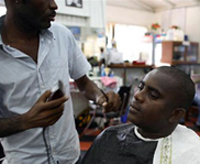
Clients at Kevin's Reflextions have an opportunity to talk about HIV.
Credit: Carina Wint
Barber shops across Georgetown, Guyana, are buzzing with chatter about the latest trends, community happenings, neighbourhood gossip and now, ways to protect young people from AIDS. The United Nations Population Fund (UNFPA), in collaboration with UNAIDS Secretariat, has identified barber shops and beauty salons as information hubs, and is using them to spread the word about HIV prevention.
The project involves the training of shop staff to answer simple HIV-related questions, pass out informational material, dispense both male and female condoms to clients – and even provide on-site counselling and testing. As a result, young people in Guyana are given access to information and resources not readily available elsewhere in their communities. And this is important because their small country (population 751, 223) has one of the highest HIV prevalence levels in the region: about 1.6 per cent for pregnant women, according to UNAIDS. Among sex workers, prevalence rises up to 26.6 per cent.
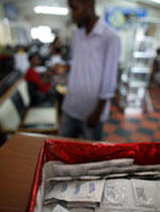
Male and female condoms are available at selected hair salons.
Credit: Carina Wint
Juanita Huburn, a customer at DJ’s Magic Fingers, a hair salon that participates in the programme, described Guyanese society as “closed” when it comes to issues regarding sexuality. “You do not talk about sex, they just say you should not have sex, but this is not realistic,” she said.
Shops and salons were chosen based on their location in malls, parks, popular attractions, or low-income communities. Owners who opened their doors to the project got added marketing exposure for their small businesses and were provided with incentives, such as access to promotional materials. “Shops were informed how their companies would be promoted through the project, and the economic value of participating,” said UNFPA Guyana Liaison Officer, Patrice La Fleur “They would most importantly provide safe places to discuss sexuality and the prevention of HIV.”
Shops were informed how their companies would be promoted through the project, and the economic value of participating. They would most importantly provide safe places to discuss sexuality and the prevention of HIV.
UNFPA Guyana Liaison Officer, Patrice La Fleur
Once the locations were identified, two employees from each shop were sent for training on basic HIV education and prevention means. They were also taught to properly monitor the project and introduced to safe practices within the context of their own work (for example, ensuring the sterility of hair cutting machines, razors, needles for stitching and weaving, manicure and pedicure implements, and tattooing and body piercing equipment).
In addition to training participants about sexual and reproductive health and gender issues, the project also focuses on building life skills such as communication, healthy relationships, and leadership. “Participants expressed personal gains in their quality of relationships with friends, family, and clients,” said UNFPA Programme Officer, Babsie Giddings who monitors the project.

DJ's Magic Fingers hair salon is another venue for building awareness of HIV prevention.
Credit: Carina Wint
Since the programme was put in place businesses report a steady boost in clientele and more shops have come on board. “Business has increased about 5 per cent since we joined this programme,” said Kevin John, owner of the Barber Shop Kevin’s Reflections. He believes it may be partly because people know his salon equipment is sanitized. Currently over 7000 male and 400 female condoms are distributed monthly by requests in the shops and salons.
Work on the project was initiated last year through efforts of the UN Country Theme Group and it has been fully funded by UNAIDS. Also collaborating on the project is a local NGO, Youth Challenge Guyana.
UNFPA provides continuous support with regular follow-ups and monitoring for participating barber shops and salons. The project aims to afford some 2000 young people access to information, skills, services and supplies they can use to protect their health.
Right Hand Content
Cosponsors:
Feature stories:
Condoms and HIV prevention: Position statement by UNAIDS, UNFPA and WHO (19 March 2009)
Challenging violence against women a key task for newly launched Caribbean Coalition on Women, Girls and AIDS (06 March 2009)
More prevention focus needed for the Caribbean to sharpen its response to HIV (22 December 2008)
Publications:
Keeping Score II: A progress report towards universal access to prevention, treatment, care and support in the Caribbean (pdf, 2,87 Mb)

Feature Story
UNODC and Iran sign agreements to reduce vulnerability of women and Afghan refugees to drugs and HIV
24 March 2009
24 March 2009 24 March 2009This story was first published on UNODC.org
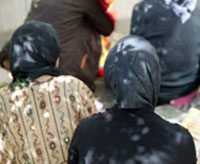
Women in Iran. Credit: UNAIDS/P. Virot
The Executive Director of the United Nations Office on Drugs and Crime (UNODC), Antonio Maria Costa, and the Deputy Secretary General of the Islamic Republic of Iran's Drug Control Headquarters, Taha Taheri signed, on 19 March, two projects to provide HIV prevention and care services to Afghan refugees and female drug users in Iran. These projects will be launched thanks to funding from the Government of the Netherlands.
The goal of the first project is to support national efforts to provide comprehensive HIV prevention and care services to Afghan refugees in Iran who are drug users. This is part of a sub-regional project also targeting Afghan drug-dependent refugees in Pakistan as well as those who have returned to Afghanistan. UNODC, in association with the United Nations High Commissioner for Refugees, UNAIDS and the International Organization for Migration, will assist in delivering comprehensive HIV prevention, treatment, care and support services to Afghan refugees under this initiative. The Governments of Afghanistan and Pakistan will also be part of this three-year project.
The hardships of Afghan refugees are compounded, not solved, by drugs. We need to reach out to this vulnerable group, and lower their vulnerability to drug abuse and the spread of HIV/AIDS through injecting drug use.
Antonio Maria Costa, Executive Director of the United Nations Office on Drugs and Crime (UNODC)
According to the latest information, there are more than 900,000 Afghan refugees in Iran, down from a peak of 2 million in 2002/03. This is one of the largest refugee populations in the world. "The hardships of Afghan refugees are compounded, not solved, by drugs. We need to reach out to this vulnerable group, and lower their vulnerability to drug abuse and the spread of HIV/AIDS through injecting drug use", said Mr. Costa. This group has been identified as being high-risk, yet has thus far not fully benefited from Iran's large-scale comprehensive HIV prevention, treatment, care and support services to injecting drug users - including opioid substitution treatment.
The second project targets another vulnerable group; Iranian women who are either drug dependent and/or affected by HIV. The aim of the project is to increase access to quality services tailored to the specific needs of these women, including in prison settings. This will complement the significant resources that the Government of Iran already devotes to prevention and treatment of HIV as well as drug demand reduction measures.
"These agreements are further evidence of UNODC's pro-health approach to drugs, and to a deepening of our partnership with the Islamic Republic of Iran," said Mr. Costa. "UNODC is grateful for the financial assistance from the Netherlands". He urged other funding partners to follow suit and reduce the vulnerability of women and Afghan refugees in Iran to drugs and HIV. "This is an often neglected and humanitarian side of drug control", said the head of UNODC.
Right Hand Content
Cosponsors:
Press centre:
High Commissioner calls for focus on human rights and harm reduction in international drug policy (10 March 2009)
Feature stories:
OPINION: Silence on harm reduction not an option (11 March 2009)
Injecting drug use and HIV: Interview with UNAIDS Team Leader, Prevention, Care and Support team (11 March 2009)
51st session of the Commission on Narcotic Drugs (11 March 2008)
Injecting drug use: focused HIV prevention works (11 May 2007)
Speeches:
“Why we need harm reduction to reach universal access goals” Speech by Michel Sidibé, Executive Director of UNAIDS to Donor Conference Harm Reduction, Amsterdam (28 January 2009) (pdf, 100 Kb)
Publications:
Best Practice Publication: High Coverage Sites (pdf, 1,57 Mb)
Iran UNGASS Country Progress Report 2008 ( en | Persian ) (pdf, 531 Kb | 2,59 Mb )
Region/country

Feature Story
Need for scale up in integrated TB and HIV screening to address linked epidemics
24 March 2009
24 March 2009 24 March 2009Although it is mostly preventable and curable, tuberculosis (TB) is one of the leading causes of death among people living with HIV globally. Of the 33 million people who are living with HIV, only 20% of know their status, and only a tiny fraction, 2% in 2007, were screened for TB according to the World Health Organization’s annual report on global TB control launched today.
HIV is dramatically fuelling the TB epidemic in sub-Saharan Africa, where up to 80% of TB patients are co-infected with HIV according to the report. A respiratory infection that spreads like the common cold, TB exploits an immune system already weakened by HIV.
“We have to stop people living with HIV from dying of tuberculosis,” said Mr Michel Sidibe, Executive Director of UNAIDS. “Universal access to HIV prevention, treatment, care and support must include TB prevention, diagnosis and treatment. When HIV and TB services are combined, they save lives.”
"We have to stop people living with HIV from dying of tuberculosis. Universal access to HIV prevention, treatment, care and support must include TB prevention, diagnosis and treatment. When HIV and TB services are combined, they save lives."
Mr Michel Sidibe, Executive Director of UNAIDS
Global Tuberculosis Control 2009 provides an up-to-date assessment of the TB epidemic and progress in controlling the disease. It notes that globally only 16% of TB patients know their HIV status and so the majority of HIV-positive TB patients do not know that they are living with HIV and are not accessing HIV treatment.
However, there has been progress in this area with increased HIV testing among people being treated for TB, especially in Africa. In 2004, just 4% of TB patients in the region were tested for HIV; in 2007 that number rose to 37%, and in some countries (Kenya, Lesotho, Malawi, Rwanda and Swaziland) over 70% of all TB patients know their HIV status.
Because of increased testing for HIV among TB patients, more people are getting appropriate treatment though the numbers still remain a small fraction of those in need. In 2007, 200 000 HIV-positive TB patients were enrolled on co-trimoxazole treatment to prevent opportunistic infections and 100 000 were on antiretroviral therapy.
Need for integrated TB and HIV services
For many years efforts to tackle TB and HIV have been largely separate, despite the overlapping epidemiology. Improved collaboration between TB and HIV programmes will lead to more effective prevention and treatment of TB among people living with HIV and to significant public health gains.
The release of the report today coincides with World TB Day and a 1500-strong gathering at the 3rd Stop TB Partners’ Forum in Rio.
Need for scale up in integrated TB and HIV screening to address linked epidemics
Cosponsors:
Partners:
Feature stories:
ICASA 2008: Collaborative TB and HIV activities essential (03 Dec 2008)
First HIV/TB Global Leaders Forum (09 Jun 2008)
Together against TB and HIV (23 Mar 2007)
UNAIDS interviews UN Special Envoy to Stop TB (21 Mar 2007)
Press centre:
HIV-related TB deaths higher than past estimates (24 March 2009)
External links:
3rd Stop TB Partner's Forum, Rio de Janeiro, Brazil, 23 - 25 March 2009
Publications:

Feature Story
TB/HIV, universal access, and human rights key items on UNAIDS Executive Director’s agenda in Brazil
23 March 2009
23 March 2009 23 March 2009
(from left) Executive Director, UNAIDS Michel Sidibé and Director, Stop TB Department WHO, Dr Mario Raviglione during the press conference launch of Global TB Control 2009, 24 March 2009.
Credit: UNAIDS/D. Ramalho
The Executive Director of UNAIDS, Mr Michel Sidibé, is in Brazil this week promoting greater awareness of the interlinked epidemics of HIV and tuberculosis, the need for universal access to HIV services for all people in need, and the necessity to address stigma and discrimination in Brazil’s response to HIV.
Earlier today in Rio de Janeiro, Mr Sidibé joined the international launch of the World Health Organization’s (WHO) annual report on global TB control.
Although it is mostly preventable and curable, tuberculosis (TB) is one of the leading causes of death among people living with HIV globally. Of the 33 million people who are living with HIV, only 20% of know their status, and only a tiny fraction, 2% in 2007, were screened for TB according to the Global TB Control 2009 report.
"Universal access to HIV prevention, treatment, care and support must include TB prevention, diagnosis and treatment. When HIV and TB services are combined, they save lives."
Michel Sidibé, Executive Director of UNAIDS
“We have to stop people living with HIV from dying of tuberculosis,” said Mr Sidibé. “Universal access to HIV prevention, treatment, care and support must include TB prevention, diagnosis and treatment. When HIV and TB services are combined, they save lives.”

(from left) Assistant Director-General, World Health Organization Dr Hiro Nakatani, Executive Secretary of the Stop TB Partnership, Dr Marcos Espinal; and Executive Director, Global Fund to Fight AIDS, TB and Malaria, Dr Michel Kazatchkine during the press conference launch of Global TB Control 2009, 24 March 2009.
Credit: UNAIDS/D. Ramalho
The UNAIDS Executive Director was joined at the launch by the Executive Director of the Global Fund to Fight AIDS, Tuberculosis and Malaria, Dr Michel Kazatchkine, the Assistant Director-General of the HIV/AIDS, TB, Malaria and Neglected Tropical Diseases Department at WHO, Mr Hiroki Nakatani, the Director of the Stop TB Department, Dr Mario Raviglione, and the Executive Secretary of the Stop TB Partnership, Dr Marcos Espinal.
The report launch is part of World TB Day events taking place during the 3rd Stop TB Partners Forum, which opened in Rio de Janeiro on 23 March. Mr Sidibé will deliver an address at the Forum’s closing on 25 March.
Later in the week, Mr Sidibé will travel to Brasília where he will meet with senior Government of Brazil officials including the National Congress Parliamentary group on HIV and the ministers for foreign affairs, women’s policies, health, and human rights, respectively.
To amplify UNAIDS’ messages of standing with people living with and affected by HIV and stopping laws that block the AIDS response, Mr Sidibé will meet with several key civil society actors active in promoting HIV awareness, protecting human rights, and ending stigma and discrimination, especially for those most vulnerable to HIV. One meeting will bring together national level representatives of groups representing people living with HIV, youth, women, and lesbians, gays, bisexuals and transgenders to discuss these issues within the national and local context.
In Rio de Janeiro, visits are planned to organizations providing vital services to children and young people. One such organization is Sociedade Viva Cazuza, a non-profit that supports children, young people and adults living with HIV through a broad range of services, from HIV counselling and testing to the administration of antiretroviral treatment under the auspices of Rio de Janeiro’s municipal health care system. Besides physical support, Sociedade Viva Cazuza also maintains a website where people can pose their HIV and other sexual health questions to experts.
In Latin America, Brazil has the region’s largest HIV epidemic, home to more than 40% (730,000) of people living with the virus, followed by Mexico with 200,000 HIV-positive people. But the country also benefits from a commitment to ensuring access to both HIV prevention and treatment services, which has helped keep its epidemic stable and halved AIDS mortality rates between 1996 and 2002.
On 30 March, Mr Sidibé will join the Brazilian Minister of Women’s Policies, Ms Nilcéa Freire, in inaugurating the first centre that focuses on rehabilitating men who abuse women. Located in Nova Iguaçu, a municipality in Rio de Janeiro, the centre will place emphasis on education programmes to put a stop to domestic violence. Ten other centres are planned for the country.
Mr Sidibe will conclude his official visit later that day by addressing delegates at the opening of the Global Symposium on Engaging Men and Boys in Gender Equality.
This is Mr Sidibé’s first official visit to Brazil since becoming executive director of UNAIDS.
TB/HIV, universal access, and human rights key items on UNAIDS Executive Directo
Cosponsors:
Partners:
Multimedia:
Feature stories:
Need for scale up in integrated TB and HIV screening to address linked epidemics (24 March 2009)
Press centre:
HIV-related TB deaths higher than past estimates (24 March 2009)
External links:

Feature Story
Swing and Sisters: HIV outreach to sex workers in Thailand
19 March 2009
19 March 2009 19 March 2009
Michel Sidibé, Executive Director of UNAIDS visited workers from two organizations to get first hand experience of how they carry out their outreach work among Pattaya’s sex work community.
Credit: UNAIDS/Vinai Dithajohn
Picking her way through the crowds Surang Janyan waves a friendly hello to her friend Gop. This is one of the many people she will meet tonight in Pattaya’s Walking Street – a long street running along the cost of one of Thailands red light areas.
Surang Janyam is the Founder and Director of Swing, a small organization which provides support for sex workers in Thailand. She regularly visits Gop around midnight to check whether she or her staff need anything. Gop is the owner of one of Pattaya’s most popular bars, the Wild West Boys, where men go to watch a show and pay to spend time with the male sex workers, in the bar or for sexual services in private.
Gop has around 70 sex workers working for her and Surang knows many of them well. “Swing workers come to talk to us and give us condoms,” said Gop. “And they show the boys how to use them properly.” Swing members and volunteers distribute several thousand condoms each month and provide information about HIV and how to protect themselves against the virus.
"HIV among sex workers and access to services are among the biggest challenges to the AIDS response in Thailand. It is extremely important that sex workers gain access to HIV prevention and treatment services without fear of discrimination."
Michel Sidibé, Executive Director of UNAIDS
“HIV among sex workers and access to services are among the biggest challenges to the AIDS response in Thailand,” said Michel Sidibé, Executive Director of UNAIDS. “It is extremely important that sex workers gain access to HIV prevention and treatment services without fear of discrimination.”
Swing works with a lot of bars and bar owners particularly. “Gaining the confidence of the bar owners is an important entry point for gaining access to the sex workers themselves,” said Patrick Brenny, UNAIDS Country Coordinator in Thailand. “Knowledge about HIV is worryingly low among sex workers in Thailand, at around 28% and it is important that they receive education about how to protect themselves and their clients.” Further down the Street Surang meets another of her friends Nueng who works for Sisters, the first counselling service in Thailand to cater exclusively for the transgender community. Pattaya is home to around 1000 transgenders in high season.
“We set up the centre in 2005 to get public support and greater acceptance of the transgender community in Pattaya,” said Nueng who is the Sisters Outreach Supervisor. “Before we started the transgender community had nowhere to go and no one to turn to for advice and support. There were services for male and female sex workers but nothing for transgender, we were on our own and people didn’t understand us.”
Pattaya, became the favourite ‘rest and recreation’ place of US troops during the Vietnam war and has since become a well trodden path on the sex tourism trail drawing in thousands of visitors a year.
Sisters, like Swing runs a drop-in centre in Pattaya where they provide medical services, counselling, skills development as well as club activities such as make-up, sports and cooking.
Nueng is transgender herself and so understands the stigma and discrimination faced by the transgender sex workers. “We have many problems because we are transgender,” she said. “If we try to access health services staff are often very unkind to us and treat us unfairly. So we try to offer our transgender sisters support and broaden awareness in the community so that people will accept us.”
Nueng wears a T-shirt the group printed for themselves so that they can be easily recognised when they carry out their outreach work. The T-shirts are bright pink and carry the words ‘Sisters, where our second home is.’
Michel Sidibé, Executive Director of UNAIDS visited workers from the two organizations this week to get first hand experience of how they carry out their outreach work among Pattaya’s sex work community. Working in partnership with sex workers to identify their needs and to advocate for policies and programmes that improve their health, safety and engagement in the AIDS response is a proven strategy and an essential feature of UNAIDS approach.
Swing and Sisters: HIV outreach to sex workers in Thailand
Multimedia:
Feature stories:
UNAIDS Executive Director visits Thailand (17 March 2009)
Asia Pacific Leadership Forum meets (19 March 2009)
Publications:
UNAIDS Guidance Note on HIV and Sex Work (pdf, 238 Kb)

Feature Story
Condoms and HIV prevention: Position statement by UNAIDS, UNFPA and WHO
19 March 2009
19 March 2009 19 March 2009[Originally published in 2004 updated in 2009]

Condom use is a critical element in a comprehensive, effective and sustainable approach to HIV prevention and treatment.
Credit: UNAIDS
Condom use is a critical element in a comprehensive, effective and sustainable approach to HIV prevention and treatment. Prevention is the mainstay of the response to AIDS. Condoms are an integral and essential part of comprehensive prevention and care programmes, and their promotion must be accelerated. In 2007, an estimated 2.7 million people became newly infected with HIV. About 45% of them were young people from 15 to 24 years old, with young girls at greater risk of infection than boys.
The male latex condom is the single, most efficient, available technology to reduce the sexual transmission of HIV and other sexually transmitted infections.
The search for new preventive technologies such as HIV vaccines and microbicides continues to make progress, but condoms will remain the key preventive tool for many, many years to come. Condoms are a key component of combination prevention strategies individuals can choose at different times in their lives to reduce their risks of sexual exposure to HIV. These include delay of sexual initiation, abstinence, being safer by being faithful to one’s partner when both partners are uninfected and consistently faithful, reducing the number of sexual partners, correct and consistent use of condoms(1), and male circumcision.
Conclusive evidence from extensive research among heterosexual couples in which one partner is infected with HIV shows that correct and consistent condom use significantly reduces the risk of HIV transmission from both men to women, and also from women to men(2). Laboratory studies show that male latex condoms are impermeable to infectious agents contained in genital secretions(3). To ensure safety and efficacy, condoms must be manufactured to the highest international standards. They must be procured according to the quality assurance procedures established by the WHO, UNFPA and UNAIDS and they should be stored away from direct heat sources. Prevention programmes need to ensure that high-quality condoms are accessible to those who need them, when they need them, and that people have the knowledge and skills to use them correctly.
Condoms must be readily available universally, either free or at low cost, and promoted in ways that help overcome social and personal obstacles to their use.
Condom use is more likely when people can access them at no cost or at greatly subsidized prices. Effective condom promotion targets not only the general population, but also people at higher risk of HIV exposure, especially women, young people, sex workers and their clients, injecting drug users and men who have sex with men. UNFPA estimates that the current supply of condoms in low- and middle-income countries falls well short of the number required (the condom ‘gap’)(4). Despite the gap, international funding for condom procurement has not increased in recent years. Collective actions at all levels are needed to support efforts of countries, especially those that depend on external assistance for condom procurement, promotion and distribution.
HIV prevention education and condom promotion must overcome the challenges of complex gender and cultural factors.
Young girls and women are regularly and repeatedly denied information about, and access to, condoms. Often they do not have the power to negotiate the use of condoms. In many social contexts, men are resistant to the use of condoms. This needs to be recognized in designing condom promotion programmes. Female condoms can provide women with more control in protecting themselves. However, women will remain highly vulnerable to HIV exposure, until men and women share equal decision-making powers in their interpersonal relationships.
Condoms have played a decisive role in HIV prevention efforts in many countries.
Condoms have helped to reduce HIV infection rates where AIDS has already taken hold, curtailing the broader spread of HIV in settings where the epidemic is still concentrated in specific populations.
Condoms have also encouraged safer sexual behaviour more generally. Recent analysis of the AIDS epidemic in Uganda has confirmed that increased condom use, in conjunction with delay in age of first sexual intercourse and reduction of sexual partners was an important factor in the decline of HIV prevalence in the 1990s(5). Thailand’s efforts to de-stigmatize condoms and its targeted condom promotion for sex workers and their clients dramatically reduced HIV infections in these populations and helped reduce the spread of the epidemic to the general population. A similar policy in Cambodia has helped stabilize national prevalence, while substantially decreasing prevalence among sex workers. In addition, Brazil’s early and vigorous condom promotion among the general population and vulnerable groups has successfully contributed to sustained control of the epidemic.
Increased access to antiretroviral treatment creates the need and the opportunity for accelerated condom promotion.
The success of antiretroviral therapy in industrialized countries in reducing illness and prolonging life can alter the perception of risk associated with HIV(6). A perception of low-risk and a sense of complacency can lead to unprotected sex through reduced or non-consistent condom use. Promotion of correct and consistent condom use within antiretroviral treatment programmes, and within reproductive health and family planning services, is essential to reduce further opportunities for HIV transmission. Rapid scale-up of HIV testing and counselling is needed to meet the prevention needs of all people, whether they are HIV-positive or negative.
1 UNAIDS. 2004 Report on the global AIDS epidemic, page.72.
2 Holmes K, Levine R, Weaver M. Effectiveness of condoms in preventing sexually transmitted infections. Bulletin of the World Health Organization. Geneva. June 2004.
3 WHO/UNAIDS. Information note on Effectiveness of Condoms in Preventing Sexually Transmitted Infections including HIV. Geneva. August 2001.
4 UNFPA. 2007 report on donor support for contraceptives and condoms for STI/HIV prevention 2007.
5 Singh S, Darroch J.E, Bankole A. A,B, and C in Uganda: The Roles of Abstinence, Mongamy and Condom Use in HIV Decline. The Alan Guttmacher Institute. Washington DC. 2003.
6 Gremy I, Beltzer N. HIV risk and condom use in the adult heterosexual population in France between 1992 and 2001: return to the starting point? AIDS 2004;18:805-9.
Condoms and HIV prevention: Position statement by UNAIDS, UNFPA and WHO
Cosponsors:
Press centre:
UNAIDS promotes combination HIV prevention towards universal access goals (18 March 2009)
Download printable version (pdf, 54 Kb)
Feature stories:
UNAIDS Executive Director visits Thailand (17 March 2009)
Asia Pacific Leadership Forum meets (19 March 2009)
Publications:
Best practice: Making condoms work for HIV prevention (pdf, 1.1 Mb)

Feature Story
Asia Pacific Leadership Forum meets
19 March 2009
19 March 2009 19 March 2009The 7th Steering Committee of the Asia Pacific Leadership Forum met today in the Thai capital Bangkok to discuss progress made and to design ways forward for work on HIV in the region.
The meeting was opened by the Executive Director of UNAIDS Mr Michel Sidibé who encouraged the leaders to focus on partnership building for a truly comprehensive response to the epidemic.
Lady Roslyn Morauta, the Australian Ambassador on HIV chaired the meeting and gave opening remarks about the actions taken on the recommendations made at the 6th APLF Steering Committee meeting.
The steering committee meets once a year to review progress and provide guidance on future strategies and activities for leadership mobilisation. The APLF works primarily at country level through the UNAIDS country offices which in turn work in partnership with government, civil society groups and the private sector to further the AIDS response in Asia Pacific.
At the invitation of the Thai Government, UNAIDS Executive Director Mr Michel Sidibé has spent the week in Thailand meeting government and civil society partners. During his stay Mr Sidibé also met with the Prime Minister of Thailand Abhisit Vejjajiva.
Asia Pacific Leadership Forum meets
Feature stories:
UNAIDS Executive Director visits Thailand (17 March 2009)
Swing and Sisters: HIV outreach to sex workers (19 March 2009)

Feature Story
UNAIDS Executive Director visits Thailand
16 March 2009
16 March 2009 16 March 2009
UNAIDS Executive Director Mr Michel Sidibé (left) with the Prime Minister of Thailand.
Credit: Gov. of Thailand
At the invitation of the Thai Government, UNAIDS Executive Director Mr Michel Sidibé is in Thailand this week to discuss progress in the response to AIDS and visit projects to get a better understanding of how HIV prevention and treatment efforts are making a difference to peoples lives.
Today in Bangkok Mr Sidibé hosted a meeting with civil society partners in the region. In his meeting with national and regional civil society partners, discussions took place on closer collaboration to further the AIDS response.
During his stay Mr Sidibé will meet with the Prime Minister as well as Ministers of Public Health, Interior and Foreign Affairs. Thailand is recognized as a visionary leader in the AIDS response, particularly in scaling up services to prevent the transmission of HIV from mothers to their children. The country also has expertise on HIV counselling and testing and on sexual and reproductive health services for young people which will be one of the topics that Mr Sidibé will be discussing in detail with the Minister of Public Health.

During his country visit to Thailand, UNAIDS Executive Director, Michel Sidibé met with representatives from the Thai and Regional Civil Society, Bangkok, 17 March 2009.
Credit: UNAIDS/P. de Noirmont/Asiaworks
Later in the week Mr Sidibé will visit the seaside resort of Pattaya where an HIV prevention outreach project is aiming to improve the health of the local men, women and transgendered who sell sex to tourists. Pattaya, once a quiet fishing village, is now a magnet for “sex tourism” drawing people from all over the world to buy sex.
Mr Sidibé will conclude his official visit by addressing Asian leaders at the opening of the Asia Pacific Leadership Forum.
This will be Michel Sidibé’s first official visit to Asia since becoming executive director of UNAIDS.
UNAIDS Executive Director visits Thailand
Multimedia:
Feature stories:
‘Positive partnerships’ break down AIDS-discrimination in Thailand (30 March 2006)
Swing and Sisters: HIV outreach to sex workers in Thailand (19 March 2009)
Asia Pacific Leadership Forum meets (19 March 2009)
Publications:
UNAIDS Guidance note on HIV and sex work (pdf, 239 Kb)

Feature Story
3% of US capital city living with HIV
16 March 2009
16 March 2009 16 March 2009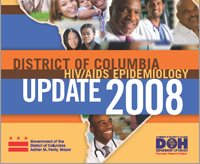
The District of Columbia HIV/AIDS Epidemiology Update 2008 report.
At least 3% of residents in Washington D.C. are living with HIV according to a report published today by US health officials at the District of Columbia's HIV/AIDS Administration.
The leading mode of transmission of HIV in the district is men having sex with men. Heterosexual transmission and injecting drug use closely follow, the report says.
"Today’s findings by US health officials show that there is no room for complacency in responding to HIV. We must continue to learn from each other and work together - both in developing and high-income countries – to ensure universal access to HIV prevention, treatment, care and support services for citizens."
Paul de Lay UNAIDS Deputy Executive Director, Programme, ad interim and Director of Evidence, Monitoring and Policy
“Today’s findings by US health officials show that there is no room for complacency in responding to HIV,” said Paul de Lay UNAIDS Deputy Executive Director, Programme, ad interim and Director of Evidence, Monitoring and Policy.
“We must continue to learn from each other and work together - both in developing and high-income countries – to ensure universal access to HIV prevention, treatment, care and support services for citizens.”
The District of Columbia HIV/AIDS Epidemiology Update 2008 reports that HIV is found in all demographics in Washington: more than 4% of African-Americans, almost 2% of Latinos and 1.4% of Caucasians are living with HIV. However African-American men are disproportionably affected, accounting for 76% of people living with HIV.
This follows the broader pattern across the United States where racial and ethnic minorities are disproportionately affected by the HIV epidemic. Although African Americans represent about 13% of the population (US Census Bureau, 2006), in 2005 they accounted for 48% of new HIV diagnoses.
The United States of America has one of the largest HIV epidemics in the world, with an estimated 1.2 million people living with HIV in 2007 (UNAIDS, 2008).
3% of US capital city living with HIV
Publications:
District of Columbia HIV/AIDS Epidemiology Update 2008 (pdf, 12.36 Mb)

